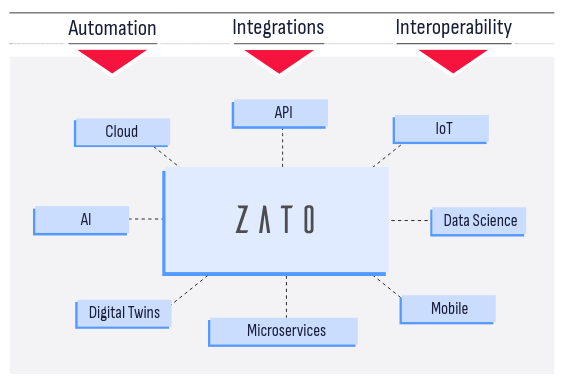SATO Vicinity
How SATO ensured a smooth update of an existing product with Zato Source's integrations support
SATO Vicinity develops and sells products that use its global-standard PJM RFID (Phase Jitter Modulation Radio Frequency Identification) technology to track and identify tagged items. Uniquely, PJM RFID can quickly identify large amounts of tagged items with 100% accuracy, even when randomly or tightly packed. A subsidiary of electronics manufacturer SATO Global, SATO Vicinity builds high-end, customized applications for customers worldwide from industries including healthcare, blood and pathology, and wholesale diamonds.
The challenge
Updating a product to replace legacy technology, including Microsoft SQL and Oracle integrations.In 2013, SATO Vicinity developed Orbit, an application to help orthopedic implant suppliers work more efficiently when checking and logging unused items returned to them.
Orthopedic suppliers provide hospitals with loan sets which each contain up to 12,000 implants, screws, and related items. After surgery, the hospital returns unused items to the supplier, who checks them so they can correctly bill the hospital for items used.
Previously, companies had to painstakingly sort and check items manually - often hundreds per day. It was slow, time consuming, and carried the risk of human errors.
Orbit uses PJM RFID tags and readers to significantly speed up this process while ensuring 100% accuracy. This helps orthopedic implant suppliers operate more efficiently when booking loan sets, dispatching items, reconciling returned items, and billing. Turnaround times up to 75% faster mean com- panies can fulfill more orders in less time.
SATO Vicinity initially developed Orbit using Adobe Flex for the front end, and Adobe ColdFusion and a Microsoft SQL database for the back end. When Adobe discontinued the use of Flash, SATO Vicinity faced the challenge of needing to rebuild Orbit using different technology.
Because Orbit was developed specifically to meet the needs of orthopedic implant companies, it was crucial it continued to function in the same way from the customers' perspective. Any disruptions to their day-to-day operations caused by the tech- nology change could have serious implications for their productivity, and ultimately their bottom line.
SATO Vicinity needed a flexible, powerful solution that would provide the same functionality as already existed in Orbit's back end, and would integrate with Microsoft SQL and Oracle. The company also wanted to update Orbit's user interface to make it more user friendly.
The solution
Building Orbit 2 in Zato to take advantage of its integrations capabilities and ease of use.SATO Vicinity decided to rebuild Orbit using the open source, Python-based Zato platform. Flexible, powerful, and capable of complex integrations, Zato had already proved its value in developing other key SATO Vicinity products requiring multiple integrations. The Zato Source team's deep expertise and superior service also influenced their decision.
SATO Vicinity and Zato Source worked together to develop Orbit 2. Zato Source ensured smooth integrations with the Microsoft SQL and Oracle databases necessary for Orbit to function. Ensuring Orbit can communicate with the RFID readers via SATO's application PJM Global was straightforward, as PJM Global was also built in Zato.
The team also developed a more streamlined and intuitive user interface, again using Zato. "The functionality of Orbit remains the same in terms of the reverse logistics. But because we needed to update the product anyway, we wanted to make it as seamless as possible for the end user," explains Daryl Dusheiko, Chief Solutions Architect at SATO Vicinity.
The outcome
A seamless switch to Orbit 2 and further integrations planned.When Orbit 2 rolled out, how much difference did existing Orbit users notice? Very little - which in this instance, was a marker of success. Everything is working smoothly, meaning no disruption to Orbit users' business operations.
Working with Zato Source to develop Orbit 2 has provided some significant differences to the experience of developing the original Orbit platform.
"Previously, when we had problems with ColdFusion while developing Orbit 1, there wasn't anyone we could easily get in contact with. So we had to do a lot of fault-finding and diagnosis by reading forums. It was very slow and often it wasn't easy to get a solution. Whereas now with Zato Source, if we have a question they'll deal with it within a few days, or even less."
